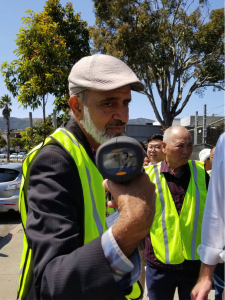Engaging Seniors in Vision Zero: A Visitacion Valley Training
Armed with speed detectors and surveys, Visitacion Valley seniors from the Asian Pacific American Community Center took to their local street to audit the safety of the intersection of Bayshore Boulevard and Arleta Avenue. Staff from Assemblymember David Chiu’s office, San Francisco Municipal Transportation Agency (SFMTA) representatives, and local Vision Zero advocates, joined the seniors to document the daily dangers of walking on their local city streets.
The Asian Pacific American Community Center is located near the high-injury intersection of Bayshore Boulevard and Arleta Avenue in Southeastern San Francisco. Most of the seniors who rely on the Asian Pacific American Community Center’s programming get to and from the center using bus lines and light rail service that stop by the busy intersection. The street audit was a perfect opportunity to invite city officials and local politicians to learn more about the seniors’ experiences using this dangerous intersection.
Walk San Francisco began the event with a training to introduce the seniors to Vision Zero and provide them with skills to advocate for safer streets in their neighborhood. In the battle against traffic violence, knowledge is power. The training not only educated seniors about the issues at hand. but also the design solutions available to make walking safe. Walk SF’s Safe Streets for Seniors presentation highlighted street engineering treatments for safer streets, so the seniors could ask for these improvements from city officials and politicians.
Following the presentation, Walk SF led the seniors on a walk audit to study the safety conditions at the dangerous, five-way intersection of Bayshore Boulevard and Arleta Avenue. During the audit, seniors split into smaller groups that were paired with city transportation officials and politicians in order to share their experiences and concerns about walking at the audit site.
The seniors raised street safety issues around the lack of crossing times, restricted access from cars parking on the sidewalk, and general navigation issues with narrow and poorly-maintained sidewalks. The walk audit also allowed seniors to share concerns about motorists speeding and blocking the crosswalk, after sighting multiple examples during the walk. Armed with the skills from the presentation, the seniors were able to make a request for larger bulb-outs and road diets to help reduce speeding traffic and make the street safer for pedestrians.

Asian Pacific American Community Center volunteer holds up a speed gun he used to measure a car going 42 mph, which is 7 mph over the speed limit on Bayshore Boulevard.
In San Francisco, speeding is the top factor in severe and fatal collisions, causing 10 times more injuries than drunk driving. Every mile per hour can be the difference between life and death. If someone is hit by a car going 20 mph, they have a 10% chance of being killed. At 40 mph, that chance increases to 80% for an average adult. For seniors, the risk is at least 90%.
During the walk audit, the seniors also used radar guns to measure the speed of traffic on Bayshore Boulevard. During the assessment, the seniors clocked cars speeding up to 42 mph on Bayshore – seven miles over the 35 mph speed limit.
After the walk audit, the seniors returned to the Asian Pacific American Community Center to review and discuss what they had noted in their small groups. SFMTA staff and Assemblymember Chiu’s staff took notes assured them that their concerns would be shared with the engineers and planners already working on longer term projects that included a redesign of the intersection. Since the training, SFMTA staff has expressed interest in returning to the Community Center to share next steps with the seniors.
The day’s training event highlighted the inequities in traffic violence facing seniors. Although seniors make up only 14 percent of San Francisco’s population, they make up at least 50 percent of pedestrians killed in traffic crashes each year. The City’s Vision Zero plan to eliminate all traffic deaths and severe-injury crashes by 2024 is a critical effort to create safer streets to address the higher risks of traffic violence for seniors.
[divider height=”1″ bg_color=”orange” margin=”20″ /]This post has been made possible by the grant-funded Focus Cities California program, a joint project of UC Berkeley SafeTREC and California Walks that supports increased safety in walking and biking.
Funding for this program was provided by a grant from the California Office of Traffic Safety, through the National Highway Traffic Safety Administration.

